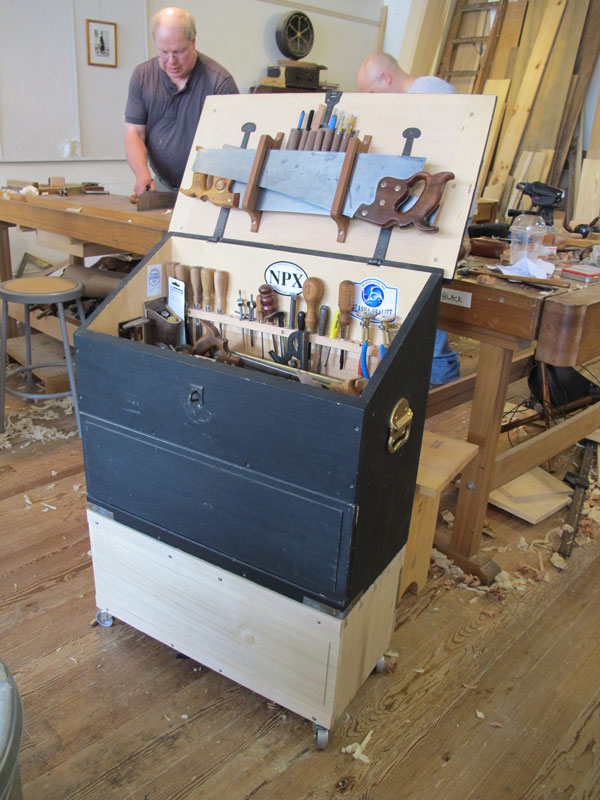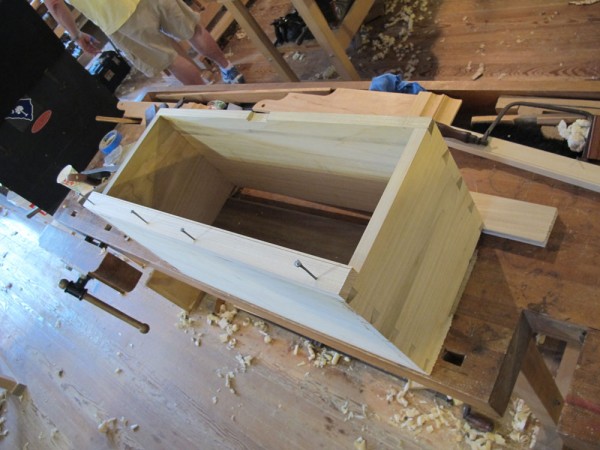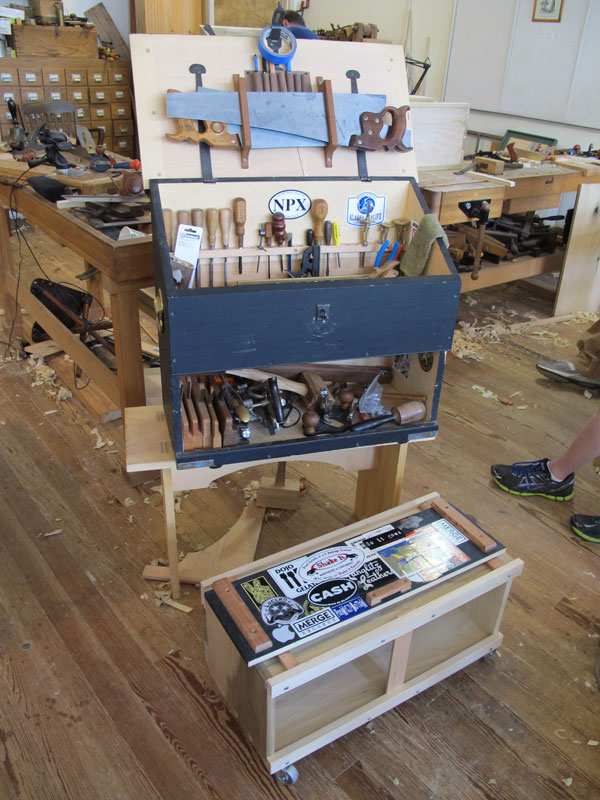We may receive a commission when you use our affiliate links. However, this does not impact our recommendations.
This week, I built a lower cabinet for my small Dutch tool chest, a project featured in the October 2013 issue of Popular Woodworking Magazine. The unit I just built sits below the tool chest proper and does a few nice things.
1. It gives me extra space for tooling and hardware that I sometimes need to drag along to classes I teach.
2. It raises the main tool well of the Dutch chest about 12”, meaning I don’t have to put the chest on a sawbench to raise it to a pleasant working height.
3. Four 2” metal casters make the whole thing easy to roll around. The fact that the two units can be taken apart makes it easy to transport everything in my SUV.
I built this lower unit while simultaneously teaching a class on building the upper unit at Roy Underhill’s The Woodwright’s School – with the help of your helpful editor, Megan Fitzpatrick. Here are some details of the lower unit’s construction (a SketchUp drawing and cutting list can be found in this earlier entry).
The case’s sides, top and bottom are joined with through-dovetails – four tails to a corner to make things easy. The back of the case is made using tongue-and-grooved boards. That’s all pretty typical stuff. The front of the case, however, is a little unusual.
The front of the case has two rails – one at the top and one at the bottom – that are glued and nailed to the dovetailed case. Between these rails is a loose panel, called the fall-front, which is secured to the case with a sliding lock that works like a machinist’s chest.
The lock is simple. A thin slip of wood slides between notches and catches in the carcase and the fall-front. If you study the SketchUp drawing for 5 minutes, you’ll get a full understanding of the mechanism.
Several of the students asked about how the locking mechanism on the lower cabinet would work with the locking mechanism on the upper cabinet. Here is the answer:
They lock independently. When moving the chests, I’ll lock the top cabinet and put it in my truck. Then I’ll lock the lower cabinet and put it in my truck. When I get to my destination, I’ll remove the lower cabinet and unlock it. Then I’ll put the top cabinet on top of that and unlock it.
So yeah, I can’t lock and unlock the lower cabinet while it is below the top cabinet. And yeah, I could have gotten around this little tiny problem by using a cupboard lock on the lower cabinet. But I wanted the two cabinets to use the same mechanism so they look like they were made for each other. Which they were.
At the end of this three-day class, Megan and I loaded up the lower cabinet with nails and a bunch of extra detritus I’d hauled down for the class. Then we locked it up and rolled it out of the way. Nice.
When I get home on Monday I’ll paint the sucker black and start applying stickers to the new unit of the chest. Roy gave me a new sticker that features a toad that’s riding a stork. I think that’s what it is.
— Christopher Schwarz
Here are some supplies and tools we find essential in our everyday work around the shop. We may receive a commission from sales referred by our links; however, we have carefully selected these products for their usefulness and quality.












Nice job. I must say that the Dutch chest form really appeals to me. Totally no-nonsense and workmanlike.
Still working on finishing up my version–have the hardware and paint and hopefully some time this weekend.
I really like the idea of this lower chest, but the instructions for how to lock and unlock it are a bit complicated. Maybe you can post a video to explain. Thanks in advance! I should have taken a closer look when I had a chance in Pittsboro.
Hi,
been looking at building a portable tool chest as I am a teacher of woodshop and then do side jobs and instals.
I think I am nearly finished with my concept. Its similar to this chest with the milkman workbench on top as the lid and the festool t lock system made with wood on the front to lock it down.
nothing new but borrowing from ur designs greatly.
I’m not a hand tool only person but my block and jackplane go everywhere with me along with my two cherry chisels and jap saws. will have the base for my power tools, Drills Jigsaw and the like.
now all I Have to do is find the time.
I’m really liking the idea of the Dutch chest. The full-blown American/British chest is a bit daunting in terms of space on the floor (My workshop is the storage of last resort in our house) and the investment in building it. Being a newbie, I’d be worried about messing up a full-size chest… That, and I hardly have enough hand tools to fill the Dutch chest!
Changing the topic a bit, but are you bringing the Dutch tool chest class on the road again next year, specifically, to Australia? I’ll drop everything (except my wedding, April 5th) to get there if you do!
Firstly, I am surprised that it has taken Chris so long to come up with this, it was the first thing I thought of when I cut out the sides of the chest and saw how far I was going to have to bend down to reach stuff in the chest.. Of course, my chest is still just a pile of boards sitting in the laundry room.
Secondly: For those of us wanting to keep the door closed but not fully locked, so that the bottom chest does not become a new home for furry freeloaders, just put a couple of rare earth magnets in pockets in either the door or the sides, then a couple of screws or clout nails opposite will keep the door closed well enough to protect the contents but make it readily opened and closed again without faffing around with keys or slips of wood. Easy.
Don’t you have some nice Alaskan stickers to put on there!!!!
Nice idea! If I had seen this last year I may have re-thought my choice of tool chests. About the bottom lock, maybe a simple rotating cam made of wood type deal. Might look better than a cabinet lock.
Interesting bench under the upper unit in the last photo. Is that a double tenon or a wedged tenon?
I am in the middle of building the lower unit. I was sold when I saw your first post. I am going to skip the sliding lock on the lower unit. Mainly because I am just to lazy to take the top chest off every time I want something out of the lower unit.